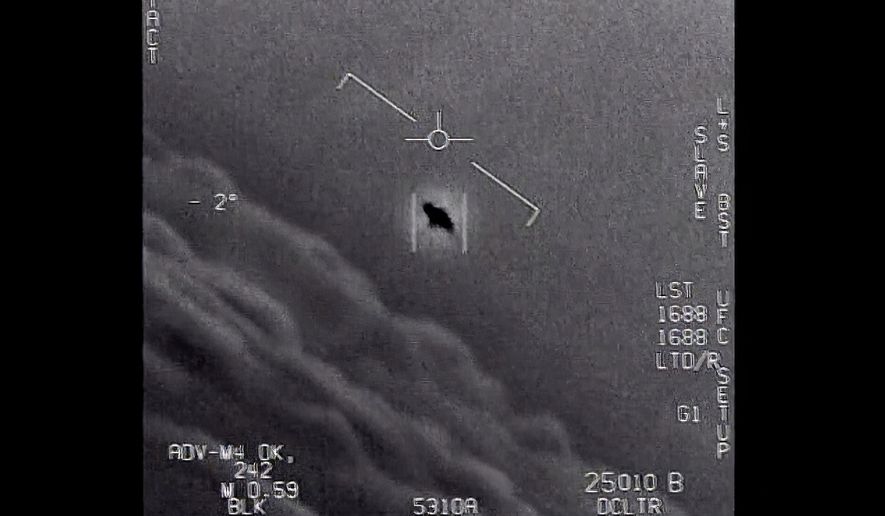A string of UFO sightings by military personnel remains largely unexplained but could involve “breakthrough technologies” that pose serious threats to national security, and the federal government must collect much more data before reaching any firm conclusions, the Pentagon and the Office of the Director of National Intelligence said in a highly anticipated report released Friday.
The study is the government’s most comprehensive look in decades at UFOs, which the report calls “unidentified aerial phenomena,” or UAP. Still, the report hardly offers the concrete answers that many lawmakers, scientific researchers and paranormal enthusiasts anticipated. A classified portion reportedly was delivered to Congress. Lawmakers of both parties praised the serious government investigation but stressed that it was “inconclusive.”
In the unclassified materials that the ODNI posted online, the government says the dozens of UFO sightings may have a host of explanations, including airborne clutter, natural phenomena and “foreign adversary systems,” such as high-tech weapons or aircraft fielded by China or Russia.
The study does not offer a firm conclusion on whether the unidentified craft could be of extraterrestrial origin. It groups some of the UFO sightings into a category dubbed “other.” The government says explanations for objects in the “other” category may require additional scientific knowledge. The acknowledgment is sure to fuel rampant speculation among those who believe alien beings pilot some of the craft.
The study’s major takeaway, however, is that the government has many more questions than answers.
“The limited amount of high-quality reporting on unidentified aerial phenomena hampers our ability to draw firm conclusions about the nature or intent of UAP,” the study reads.
“UAP clearly pose a safety of flight issue and may pose a challenge to U.S. national security,” it says. “Safety concerns primarily center on aviators contending with an increasingly cluttered air domain. UAP would also represent a national security challenge if they are foreign adversary collection platforms or provide evidence a potential adversary has developed either a breakthrough or disruptive technology.”
The Pentagon quickly announced plans to streamline the collection and organization of data related to UFOs in the hopes of offering a clearer picture in the future.
“This plan will be developed in coordination with various DoD components, including the military departments and the combatant commands, and with ODNI and other interagency partners,” Pentagon spokesman John Kirby said. “The plan will establish procedures for synchronizing collection, reporting and analysis of UAP; provide recommendations for securing military test and training ranges; and identify requirements for the establishment and operation of a new follow-on DoD activity to lead the effort, including its alignment, resources, staffing, authorities, and a timeline for implementation.”
Pentagon officials echoed ODNI leaders in saying that some of the UAP may represent serious national security threats. Indeed, the report says there is no immediate explanation for some of the technologies that U.S. personnel have seen.
“Additional rigorous analyses are necessary by multiple teams or groups of technical experts to determine the nature and validity of these data. We are conducting further analysis to determine if breakthrough technologies were demonstrated,” the report says.
’A first step’
DOCUMENT: Preliminary Assessment: Unidentified Aerial Phenomena
Government researchers examined 144 UFO reports. Of those, 143 remain completely or partially unexplained. One reported UFO was determined to be a “large, deflating balloon,” the report said. They theorized that others could be birds, recreational drones, ice crystals, thermal fluctuations or even simple plastic bags floating in the sky.
The release of the study follows public pressure by Congress and by a host of outside organizations that urged the most secretive arms of the federal government — most notably, the Defense Department and intelligence agencies — to reveal what they know about UFOs and the national security threats they might pose.
The Pentagon announced the formation last year of its unidentified aerial phenomena task force, designed to “detect, analyze and catalog UAPs that could potentially pose a threat to U.S. national security.” The task force was publicly disclosed after several leaked Navy videos showed military personnel encounters with unidentified craft.
The most recent footage, which the USS Omaha captured in 2019, seems to show an unidentified object disappearing into the waters off the California coast.
Key lawmakers said the study is a “first step” but by no means the end of the story.
“For years, the men and women we trust to defend our country reported encounters with unidentified aircraft that had superior capabilities, and for years their concerns were often ignored and ridiculed,” said Sen. Marco Rubio, a Florida Republican who has pressured the government to release more information about UFOs.
“This report is an important first step in cataloging these incidents, but it is just a first step,” he said in a statement Friday. “The Defense Department and intelligence community have a lot of work to do before we can actually understand whether these aerial threats present a serious national security concern.”
Sen. Mark R. Warner, Virginia Democrat and chair of the Senate Select Committee on Intelligence, said the report released Friday is merely the beginning.
“I was first briefed on these unidentified aerial phenomena nearly three years ago. Since then, the frequency of these incidents only appears to be increasing,” he said. “The United States must be able to understand and mitigate threats to our pilots, whether they’re from drones or weather balloons or adversary intelligence capabilities. Today’s rather inconclusive report only marks the beginning of efforts to understand and illuminate what is causing these risks to aviation in many areas around the country and the world.”
• Ben Wolfgang can be reached at bwolfgang@washingtontimes.com.




Please read our comment policy before commenting.